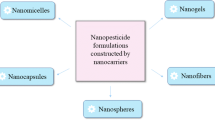
Overview
- Discusses inorganic/metallic nanopesticides and fertilizers
- Describes various aspects of inorganic and metallic nanoparticles
- Highlights the state of art in the field of inorganic/metallic nanoparticles with applications in agriculture
Access this book
Tax calculation will be finalised at checkout
Other ways to access
About this book
Similar content being viewed by others
Keywords
Table of contents (11 chapters)
-
Front Matter
Editors and Affiliations
About the editors
Dr. Hudson Wallace Pereira de Carvalho holds a bachelor’s degree in Chemistry and doctoral degree in Physical Chemistry from São Paulo State University and the University of Paris-Sud XI. An expert on the application of X-ray spectrometry to characterize nano and biosystems, he has an extensive track record on the use of nanomaterials in environmental remediation and catalytic reactions. His research focuses on the use of nanomaterials to increase crop productivity and reduce the use of pesticides and fertilizers.
Dr. Renata de Lima holds a bachelor’s degree in Biological Sciences and M.Sc. in Genetics and Evolution from the Federal University of São Carlos (UFSCar) and a Ph.D. in Medical Sciences from Unicamp. She was the coordinator of the Biotechnology undergraduate course of the University of Sorocaba from 2006 to 2014 and of the Engineering of Biotechnology and Bioprocesses undergraduate course from 2014 to 2016. She is a professor in two graduate programs at Uniso. Her interests include genetics, particularly molecular biology, cytogenetics, and mutagenesis.
Dr. Subhasis Ghoshal is a Professor of Civil Engineering at McGill University and Director of McGill’s Trottier Institute for Sustainability in Engineering and Design. He joined McGill after completing his Ph.D. at Carnegie Mellon University and a postdoctoral fellowship at the University of Michigan at Ann Arbor. He has led several inter-university research projects and international collaborations on the use of biotechnology and nanotechnology for the environmental remediation of soils and groundwater contaminated with industrial wastes.
Dr. Catherine Santaellas holds a bachelor’s degree, a Master of Engineering degree in Industrial Organic Synthesis and Process Engineering
from the University of Aix-Marseille, as well as a Ph.D. in Chemistry and a postdoctorate degree (habilitation). She is a Research Scientist at the CNRS, where she focuses on molecular, cellular, and functional responses in the rhizosphere induced by environmental stresses, such as nanomaterials and metals, and the adaptation of the soil-plant-microorganism system under biotic and abiotic stress. She has coordinated various national and international programs, including a number on safer-by-design approaches for nanomaterials and nanotoxicology.
Bibliographic Information
Book Title: Inorganic Nanopesticides and Nanofertilizers
Book Subtitle: A View from the Mechanisms of Action to Field Applications
Editors: Leonardo Fernandes Fraceto, Hudson Wallace Pereira de Carvalho, Renata de Lima, Subhashis Ghoshal, Catherine Santaella
DOI: https://doi.org/10.1007/978-3-030-94155-0
Publisher: Springer Cham
eBook Packages: Biomedical and Life Sciences, Biomedical and Life Sciences (R0)
Copyright Information: The Editor(s) (if applicable) and The Author(s), under exclusive license to Springer Nature Switzerland AG 2022
Hardcover ISBN: 978-3-030-94154-3Published: 28 May 2022
Softcover ISBN: 978-3-030-94157-4Published: 28 May 2023
eBook ISBN: 978-3-030-94155-0Published: 26 May 2022
Edition Number: 1
Number of Pages: XIX, 390
Number of Illustrations: 9 b/w illustrations, 77 illustrations in colour
Topics: Agriculture, Nanochemistry, Sustainable Development



